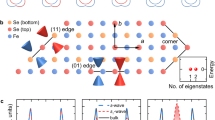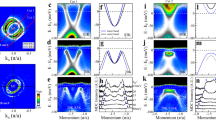Abstract
Single-layer FeSe film on SrTiO3(001) has recently come to the fore as an interfacial superconducting system, with a transition temperature that is significantly enhanced with respect to bulk FeSe. The mechanism for this enhancement, and indeed for the superconductivity itself, is therefore of great interest. Although the film has a simple Fermi surface topology, its pairing symmetry is unclear. By using low-temperature scanning tunnelling microscopy, we have systematically investigated the superconductivity of single-layer FeSe/SrTiO3 films, and report a fully gapped tunnelling spectrum and magnetic vortex lattice in the film. Quasi-particle interference patterns reveal scatterings between and within the electron pockets, and put constraints on possible pairing symmetries. By introducing impurity atoms onto the sample, we show that magnetic impurities such as Cr and Mn can locally suppress the superconductivity, but non-magnetic impurities (Zn, Ag and K) do not. Our results indicate that single-layer FeSe/SrTiO3 has a plain s-wave pairing symmetry, with an order parameter that has the same phase on all Fermi surface sections.
This is a preview of subscription content, access via your institution
Access options
Subscribe to this journal
Receive 12 print issues and online access
$209.00 per year
only $17.42 per issue
Buy this article
- Purchase on Springer Link
- Instant access to full article PDF
Prices may be subject to local taxes which are calculated during checkout






Similar content being viewed by others
References
Hsu, F. C. et al. Superconductivity in the PbO-type structure FeSe. Proc. Natl Acad. Sci. USA 105, 14262–14264 (2008).
Wang, Q. Y. et al. Interface induced high temperature superconductivity in single unit-cell FeSe films on SrTiO3 . Chin. Phys. Lett. 29, 037402 (2012).
Liu, D. F. et al. Electronic origin of high-temperature superconductivity in single-layer FeSe superconductor. Nature Commun. 3, 931 (2012).
He, S. L. et al. Phase diagram and electronic indication of high-temperature superconductivity at 65 K in single-layer FeSe films. Nature Mater. 12, 605–610 (2013).
Tan, S. Y. et al. Interface-induced superconductivity and strain-dependent spin density waves in FeSe/SrTiO3 thin films. Nature Mater. 12, 634–640 (2013).
Peng, R. et al. Measurement of an enhanced superconducting phase and a pronounced anisotropy of the energy gap of a strained FeSe single layer in FeSe/Nb: SrTiO3/KTaO3 heterostructures using photoemission spectroscopy. Phys. Rev. Lett. 112, 107001 (2014).
Peng, R. et al. Tuning the band structure and superconductivity in single-layer FeSe by interface engineering. Nature Commun. 5, 5044 (2014).
Lee, J. J. et al. Interfacial mode coupling as the origin of the enhancement of Tc in FeSe films on SrTiO3 . Nature 515, 245–248 (2014).
Zhang, W. H. et al. Direct observation of high-temperature superconductivity in one-unit-cell FeSe films. Chin. Phys. Lett. 31, 017401 (2014).
Li, Z. et al. Molecular beam epitaxy growth and post-growth annealing of FeSe films on SrTiO3: A scanning tunneling microscopy study. J. Phys. Condens. Matter 26, 265002 (2014).
Ge, J. F. et al. Superconductivity above 100 K in single-layer FeSe films on doped SrTiO3 . Nature Mater. 14, 285–289 (2015).
Mazin, I. I. et al. Unconventional superconductivity with a sign reversal in the order parameter of LaFeAsO1−xFx . Phys. Rev. Lett. 101, 057003 (2008).
Hirschfeld, P. J. et al. Gap symmetry and structure of Fe-based superconductors. Rep. Prog. Phys. 74, 124508 (2011).
Fang, C. et al. Robustness of s-wave pairing in electron-overdoped A1−yFe2−xSe2 (A = K, Cs). Phys. Rev. X 1, 011009 (2011).
Zhou, Y. et al. Theory for superconductivity in (Tl, K)FexSe2 as a doped Mott insulator. Europhys. Lett. 95, 17003 (2011).
Yang, F. et al. Fermiology, orbital order, orbital fluctuations, and Cooper pairing in iron-based superconductors. Phys. Rev. B. 88, 100504 (2013).
Maier, T. A. et al. d-wave pairing from spin fluctuations in the KxFe2−ySe2 superconductors. Phys. Rev. B 83, 100515 (2011).
Wang, F. et al. The electron pairing of KxFe2−ySe2 . Europhys. Lett. 93, 57003 (2011).
Mazin, I. I. Symmetry analysis of possible superconducting states in KxFeySe2 superconductors. Phys. Rev. B 84, 024529 (2011).
Yin, Z. P., Haule, K. & Kotliar, G. Spin dynamics and orbital-antiphase pairing symmetry in iron-based superconductors. Nature Phys. 10, 845–850 (2014).
Hu, J. P. Iron-based superconductors as odd-parity superconductors. Phys. Rev. X 3, 031004 (2013).
Balatsky, A. V. et al. Impurity-induced states in conventional and unconventional superconductors. Rev. Mod. Phys. 78, 373–433 (2006).
Yazdani, A. et al. Probing the local effects of magnetic impurities on superconductivity. Science 275, 1767–1770 (1997).
Pan, S. H. et al. Imaging the effects of individual zinc impurity atoms on superconductivity in Bi2Sr2CaCu2O8+δ . Nature 403, 746–750 (2000).
Hoffman, J. E. et al. Imaging quasiparticle interference in Bi2Sr2CaCu2O8+δ . Science 297, 1148–1157 (2002).
Wang, Q. H. et al. Quasiparticle scattering interference in high-temperature superconductors. Phys. Rev. B 67, 020511 (2003).
Hanaguri, T. et al. Coherence factors in a high-Tc cuprate probed by quasi-particle scattering off vortices. Science 323, 923–926 (2009).
Bang, J. et al. Atomic and electronic structures of single-layer FeSe on SrTiO3(001): The role of oxygen deficiency. Phys. Rev. B 87, 220503 (2013).
Song, C. L. et al. Direct observation of nodes and twofold symmetry in FeSe superconductor. Science 332, 1410–1413 (2011).
Hess, H. F. et al. Vortex-core structure observed with a scanning tunneling microscope. Phys. Rev. Lett. 64, 2711–2714 (1990).
Hanaguri, T. et al. Scanning tunneling microscopy/spectroscopy of vortices in LiFeAs. Phys. Rev. B 85, 214505 (2012).
Allan, M. P. et al. Anisotropic energy gaps of iron-based superconductivity from intraband quasiparticle interference in LiFeAs. Science 336, 563–567 (2012).
Hanaguri, T. et al. Unconventional s-wave superconductivity in Fe(Se, Te). Science 328, 474–476 (2010).
Chi, S. et al. Sign inversion in the superconducting order parameter of LiFeAs inferred from Bogoliubov quasiparticle interference. Phys. Rev. B 89, 104522 (2014).
Onari, S. et al. Violation of Anderson’s theorem for the sign-reversing s-wave state of iron-pnictide superconductors. Phys. Rev. Lett. 103, 177001 (2009).
Kariyado, T. et al. Single impurity problem in iron-pnictide superconductors. J. Phys. Soc. Jpn 79, 083704 (2010).
Grothe, S. et al. Bound states of defects in superconducting LiFeAs studied by scanning tunneling spectroscopy. Phys. Rev. B 86, 174503 (2012).
Yang, H. et al. In-gap quasiparticle excitations induced by non-magnetic Cu impurities in Na(Fe0.96Co0.03Cu0.01) as revealed by scanning tunneling spectroscopy. Nature Commun. 4, 2749 (2013).
Zhu, J. X. et al. Local electronic structure of a single nonmagnetic impurity as a test of the pairing symmetry of electrons in (K, Tl)FexSe2 superconductors. Phys. Rev. Lett. 107, 167002 (2011).
Kontani, H. & Onari, S. Orbital-fluctuation-mediated superconductivity in iron pnictides: Analysis of the five-orbital Hubbard–Holstein model. Phys. Rev. Lett. 104, 157001 (2010).
Huang, D. et al. Revealing the empty-state electronic structure of single-unit-cell FeSe/SrTiO3 . Phys. Rev. Lett. 115, 017002 (2015).
Acknowledgements
We thank X.-G. Gong and D.-H. Lee for useful discussions. This work is supported by the National Science Foundation of China, and National Basic Research Program of China (973 Program) under the grant No. 2012CB921402, No. 2011CBA00112, and No. 2011CB921802.
Author information
Authors and Affiliations
Contributions
The sample growth and STM measurements were performed by Q.F., W.H.Z. and T.Z. The data analysis was performed by Q.F., X.L., J.P.H., T.Z. and D.L.F. T.Z. and D.L.F. coordinated the whole work and wrote the manuscript. All authors have discussed the results and the interpretation.
Corresponding authors
Ethics declarations
Competing interests
The authors declare no competing financial interests.
Supplementary information
Supplementary information
Supplementary information (PDF 5729 kb)
Rights and permissions
About this article
Cite this article
Fan, Q., Zhang, W., Liu, X. et al. Plain s-wave superconductivity in single-layer FeSe on SrTiO3 probed by scanning tunnelling microscopy. Nature Phys 11, 946–952 (2015). https://doi.org/10.1038/nphys3450
Received:
Accepted:
Published:
Issue Date:
DOI: https://doi.org/10.1038/nphys3450
This article is cited by
-
Electronic inhomogeneity and phase fluctuation in one-unit-cell FeSe films
Nature Communications (2024)
-
Pair density wave state in a monolayer high-Tc iron-based superconductor
Nature (2023)
-
Identifying s-wave pairing symmetry in single-layer FeSe from topologically trivial edge states
Nature Communications (2023)
-
Charge order driven by multiple-Q spin fluctuations in heavily electron-doped iron selenide superconductors
Nature Communications (2023)
-
Atomic construction and spectroscopic characterization of FeSe-derived thin films on SrTiO3 substrates
AAPPS Bulletin (2023)



